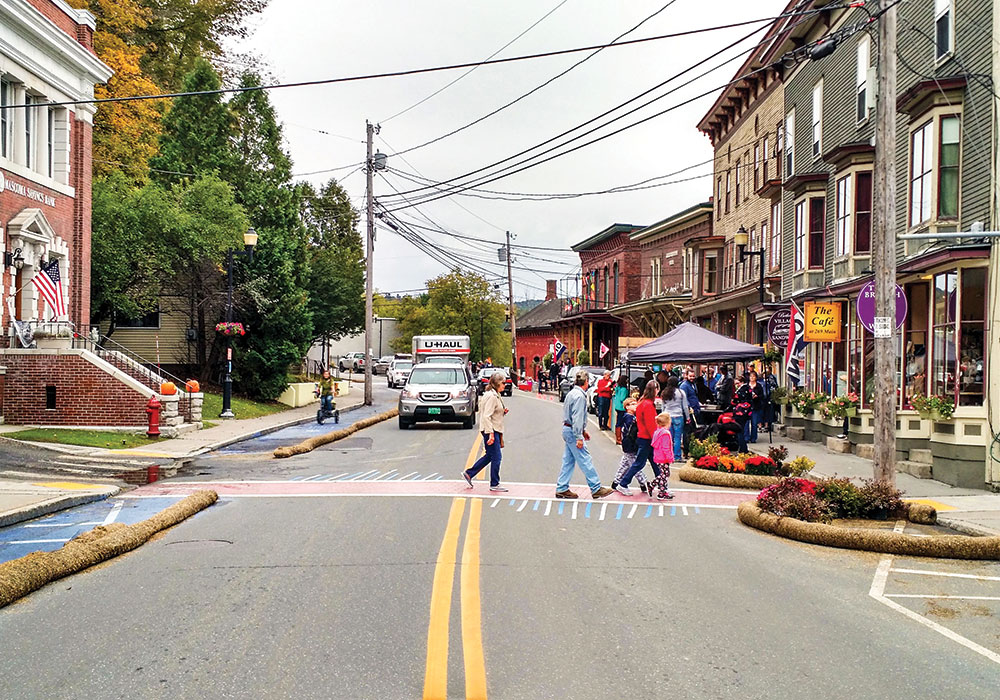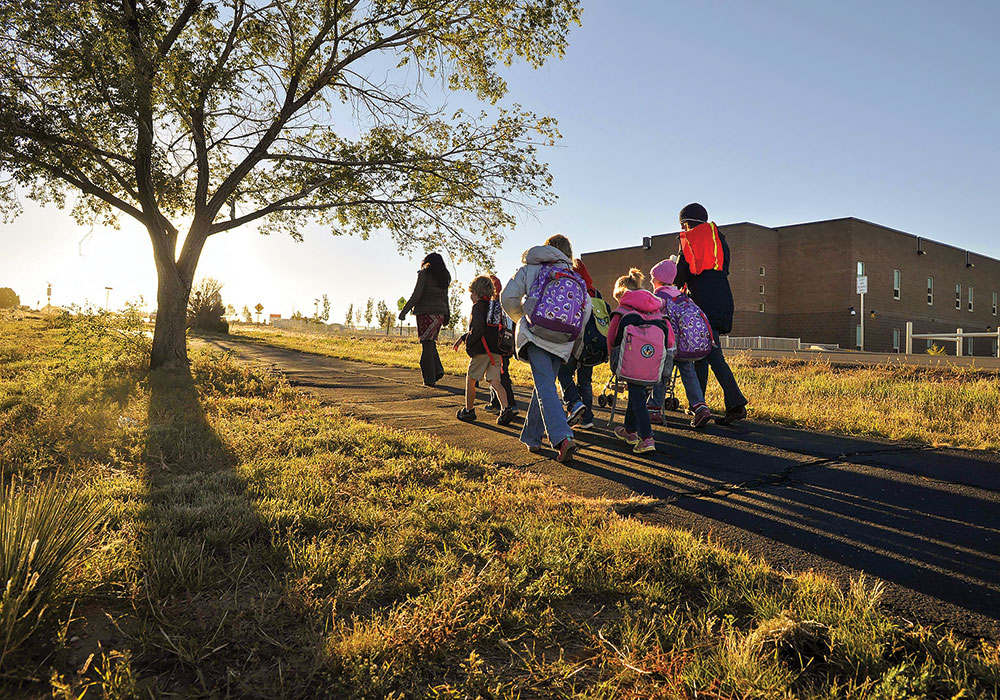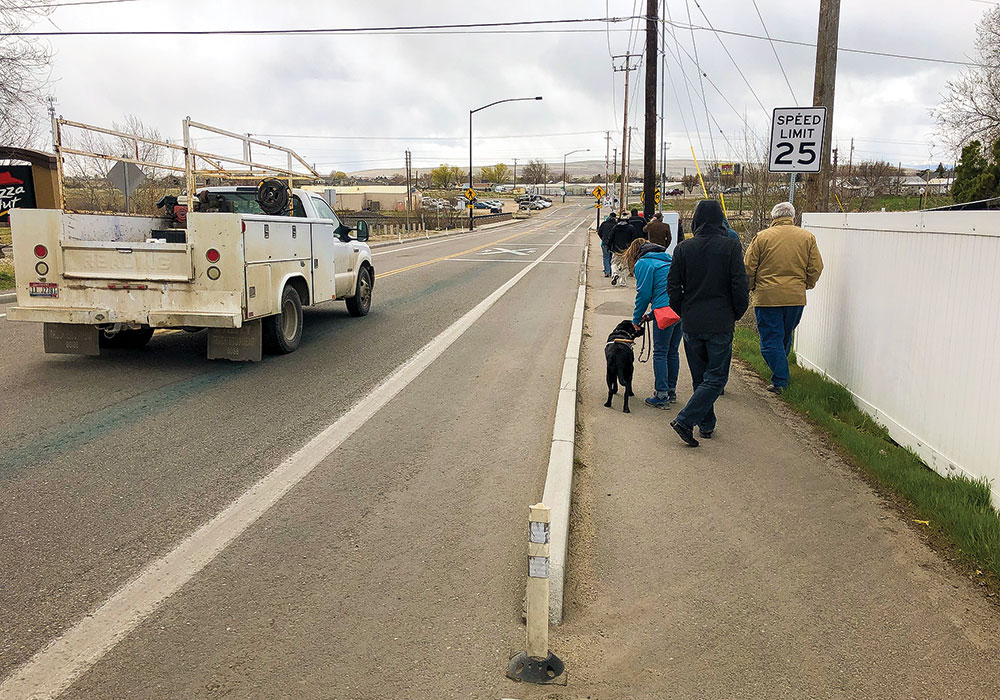Planning December 2019
Getting Rural America Back on Its Feet
Yes, rural residents want to walk — and small towns see pedestrian traffic as a way to revitalize their downtowns.
By Jay Walljasper
American life has always been characterized by distinct differences between city and country — this has provided rich material for generations of comedy routines, from vaudeville gags about naive hayseeds and shady city slickers to the 1960s sitcoms The Beverly Hillbillies and Green Acres to the reality TV adventures of Paris Hilton and Nicole Richie in The Simple Life.
But these differences don't seem so funny today as the gap widens between rural and urban dwellers in terms of economics, politics, and social attitudes. This incites widespread misconceptions. People living outside metropolitan areas feel insulted by charges that they are backward, bigoted, and unambitious. Urbanites bristle at insinuations they are somehow less American or virtuous than rural residents.
These misconceptions even color how many of us think about planning issues. At a recent national rural livability workshop sponsored by AARP, a roomful of midwesterners were asked what myths about rural America they would most like to dispel. "The idea that our communities are not walkable," was the first response, which drew an immediate round of yeses and head nods.
In many people's minds, rural Americans only walk the few steps between a parking space and their destination.
But a quick look at the facts tells a different story. A 2018 AARP national survey of U.S. adults over the age of 18 found that 30 percent of rural residents walk regularly for at least some trips.
More detailed U.S. Department of Transportation data shows that 7.2 percent of trips in towns with populations between 2,500 and 10,000 are made on foot. That figure rises to 8.5 percent in communities with populations of 10,000 to 50,000. These figures outpace those for suburbs outside the urban core, where just 6.7 of trips are pedestrian. And they are not so distant from the 12 percent of trips on foot in the urban core (defined as cities and close-in suburbs).
Another federal DOT survey suggests that rural residents strongly desire access to walking infrastructure. It found that 95 percent of them rate sidewalks as important to their community, a higher figure than for major roads, adequate parking, and airport access.
While distances can be a challenge for people walking in the countryside itself, small towns and cities seem well-suited for pedestrian transportation. Many boast extensive sidewalk networks, short distances to and around shopping districts, and less car traffic on local streets, which makes walking feel safer and less stressful.
Surprisingly, the Census Bureau noted in 2012 that the three U.S. cities with the highest percentage of people walking to work all have populations under 50,000: Ithaca, New York (pop. 20,000 — 42 percent); Athens, Ohio (pop. 25,000 — 37 percent); and State College, Pennsylvania (pop. 42,000 — 36 percent). Indeed, the only city over 100,000 in the top 15 was Cambridge, Massachusetts (pop. 111,000 — 24 percent). It's true that all but one of the 15 top listed towns were home to colleges or military bases, but it nonetheless shows the high potential to make smaller communities more walkable.

Residents in Bethel, Vermont, teamed up with AARP Livable Communities and Team Better Block to test bulb-outs, crosswalks, a mobility lane, and a parklet. The experiment led to permanent street changes and the revitalization of several downtown buildings. Photo courtesy Team Better Block.
Small-Town Strategies to Connect Communities on Foot
For a long time, pedestrians — like bike couriers — have been viewed as a city thing. But as the health and economic benefits of walkable communities become more apparent, rural communities don't want to be left behind.
Here are two approaches that have been embraced by many small towns to improve their walkability.
COMPLETE STREETS
Complete streets principles take into account the needs of all road users — pedestrians, bicyclists, transit users, children, the disabled and the elderly, not just motorists. Thirty-three states and more than 1,300 municipalities and counties have adopted complete streets legislation to guide their planning efforts, including places as small as Far Hills, New Jersey (pop. 887), Corinth, Kentucky (pop. 187), and Burt Township, Michigan (pop. 680).
The passage of a complete streets ordinance in Warsaw, Missouri (pop. 2,300) came about as part of decade-long campaign to build a multiuse trail system linking the riverfront parks to downtown, historic sites, and recreational facilities.
For more information, contact the National Complete Streets Coalition.
SAFE ROUTES TO SCHOOLS
Half of all kids walked or biked to school in 1969. Now it's less than 15 percent, but that number is going back up thanks to the rise of Safe Routes to Schools programs — including those in a number of the communities mentioned in this story.
These projects directly tackle the particular obstacles in a community that keep kids off their feet, which in many places includes schools built away from town in the countryside. That problem was solved in two Iowa towns by creating the off-road Turkey River Recreational Corridor, which connects an elementary and middle school campus within the towns of Clermont (pop. 562) and Elgin (pop. 724).
For more information contact the Safe Routes to Schools Partnership.

Safe Routes to School programs find ways to get kids on their feet — especially when schools are built on the outskirts of town. Photo by Eddie Moore/Albuquerque Journal/Zumapress.com.
Bringing life back to Main Street
Tapping this potential offers a prime opportunity to reverse the economic and population decline engulfing many rural communities. That's because there is growing evidence that walkability is a key way to stimulate economic development and attract young people to a place. Still, fewer rural residents walk than would like to.
So how do we help more people get back on their feet in rural America? "The first thing to do is make it seem OK to walk," says Dallas-based Andrew Howard, director of Team Better Block, who grew up in Altus, Oklahoma (pop. 19,000). He points to the example of his brother, who still lives in a small town and drives a short distance to work every day. His brother told him, "If I walked, every person who drove past would stop and offer me a ride."
Team Better Block, a group specializing in tactical urbanism, recommends organizing events that excite people about walking as a legitimate way to get around. "The Saturday afternoon can influence the Monday morning," Howard explains. "Get someone to try something at a special event, and they will realize, hey, walking is not that hard."
And make it fun, Howard advises. He fondly remembers a project in McAlester, Oklahoma (pop. 18,000) — hometown of country singer Reba McIntire — where people crowded the streets, all wearing red-haired wigs.
In Bethel, Vermont (pop. 2,000), Team Better Block worked with community volunteers and AARP Vermont to put on a fall festival, which included temporary curb bump-outs and painted crosswalks to slow vehicle speeds on the highway cutting through town. It was such a hit that these traffic calming measures were made permanent. That brought more businesses and people downtown, which further slowed traffic speeds. An important lesson learned, says local volunteer Rebecca Stone: "Say yes to new ideas, and then experiment to see if they work."
AARP has put a spotlight on making walking more safe and convenient in communities of all sizes because many older people are among the one-third of Americans who don't drive — a category that also includes children, people with various disabilities, and those too poor to own a car.
Rural Diversity All Over the Map
Anyone who thinks rural communities are all alike doesn't spend much time in the countryside. At a national view, isolated rural areas seem to dominate the map. But look more closely at a region — in this case, Toledo, Ohio — and you'll see a range of community types that are developing a greater interest in walking and biking. Visit the TrADE website for an interactive map of your area.

Source: RTC Beyond Urban Centers Report.
Honey, I shrunk the highway
Battle Lake, Minnesota (pop. 735) downsized a highway running through town. When hearing of the Minnesota Department of Transportation's plans to resurface Highway 78 — the town's Main Street — local citizens persuaded the agency to do a road diet, narrowing the roadway from four lanes to three, and widening the sidewalk through downtown.
The results were immediate. Twenty-one new businesses have opened in town, including a hotel and bakery, since the project was completed in 2014, reports MnDOT. "Downtown is thriving," says resident Reba Gilliand. "There is always something interesting going on."
The region's summer tourists appreciate the improvements, but the reason for doing it was to attract new families and jobs to Battle Lake. "We didn't want to become another small town on the prairie that loses people, loses our school, and becomes a ghost town," adds resident Dan Malmstrom.
Road diets reduce crashes by 29 percent, according to the Federal Highway Administration, and have been sanctioned by the agency as a "proven safety countermeasure." They address one of the biggest road safety problems in small towns — the fact that high-speed federal, state, and county highways frequently run past stores, schools, churches, offices, and other destinations frequented by pedestrians, including children.
Until recently, most planning protocols emphasized a "one-size-fits-all" uniformity along the entire stretch of a highway. That meant many Main Streets were widened — losing parking, sidewalk and amiable small-town character in the process — to accommodate motorists who would never set foot in town. (This helps explain why 50 percent of all traffic fatalities occur in rural areas, although they account for only 23 percent of the U.S. population, according to the National Highway Traffic Safety Administration.)
MnDOT, along with FHWA and many other state transportation departments, has endorsed the idea of road diets as part of an approach known as Context Sensitive Solutions, in which planners are encouraged to "exercise more flexibility in highway design."
CSS helped defuse a standoff between citizens in Grand Marais (pop. 1,200) — a scenic Minnesota harbor town on Lake Superior — and MnDOT engineers about a makeover of US Highway 61. Locals wanted curb bump-outs and other amenities to make it more hospitable to residents and tourists on foot. The engineers contended that heavy truck traffic coming in and out of Canada made that impractical.
"We were at loggerheads for the better part of the year," remembers Cook County Chamber of Commerce Executive Director Jim Boyd, until a new plan was hammered out that reduces each travel lane by a foot while adding bump-outs, painted crosswalks, 140 new trees, a public plaza, and public art. A multiuse bike/walk path will run alongside the highway, and new sidewalks will be built in some stretches currently lacking them. The debate also spurred Grand Marais to draft its own pedestrian plan, emphasizing new sidewalks on other city streets and better snow removal.

Extruded curb treatments, like these in Kuna, Idaho, are used in Emmett and other rural areas to create safe pedestrian walkways without the full cost of sidewalks. Photo by Don Kostelec.
Where the sidewalk ends
A frequent obstacle to making small towns more walkable is money — because road and sidewalk improvements cost big bucks. But don't despair, says Dan Burden, director of innovation for Blue Zones, which focuses on walkability as a key element in making communities healthier. Burden is a pioneering walkability expert who was the country's first official state pedestrian coordinator in Florida.
"Small towns don't need to replicate what big cities do" he says. "They can do things in their own way."
Adding sidewalks on already built blocks can ignite homeowner wrath because of expensive assessments, lost street trees, and the sense that their property is being taken (even though it is technically a public right-of-way). A less costly, less controversial alternative, Burden says, is "marking out a pedestrian lane on the side of residential streets with low traffic volumes and speeds — all you need is paint." He notes that small towns streets are generally wide with plentiful parking, so these lanes don't antagonize residents or motorists.
He points to a plan in Immokalee, Florida (pop. 26,000) — an unincorporated community outside Naples whose residents are 97 percent people of color — to create a walking lane from a school to a nearby lake. "They don't have the money to do sidewalks, so this will really help."
Emmett, Idaho (pop. 6,600) — an economically struggling town — just opened a three-quarter-mile pedestrian lane, making it safer for kids to walk to an elementary school located on a street with no sidewalks. Three flashing lights have been installed to alert cars and make pedestrian crossings easier. This is the first link of an eventual two-mile route connecting downtown, all three schools, and the main city park.
The lane is a five-foot asphalt extension to the road shoulder with a raised divider providing extra protection from moving traffic (periodic cuts in the divider handle storm drainage). The project cost 10 percent of a traditional sidewalk, notes designer Don Kostelec, AICP, of Boise-based Vitruvian Planning, who calls the approach "an extruded curb treatment." He says this can even work on gravel roads using railroad ties.
"You can't come into a small town with the same tool kit you'd use in Boise or Portland," notes Kostelec, who has worked in more than 20 rural Idaho communities.
Mayor Gordon Petrie — a retired judge and Iraq war veteran — champions better walking conditions in Emmett as a key plank of his limited-government philosophy. "The fundamental bottom line of why cities exist is to protect people and property — and to create the infrastructure so people can protect themselves. This includes protection from chronic disease — and walking is one of the best ways to prevent us from chronic disease."
Petrie cites the school principal as another influence on his thinking. "He's a former football player at Boise State, and he says if we get the kids' hearts pumping on the way to school, they will do better on tests and be better behaved."
Mayor Petrie walks his talk. As part of the Idaho Mayor's Walk Challenge he once covered 650 miles in a single month (averaging 21 miles a day), winning prize money to invest in pedestrian projects around town.
While budgets are constrained in rural communities, it's often easier to get things up and running, Kostelec observes. When his firm proposed a pedestrian lane marked with a painted line in Mackay, Idaho (pop. 444), one city council member — who was also the fire chief and coach of the local baseball team — piped up, "We can get the money for that at the next school fundraiser, and I can use the line marker from the baseball diamond to apply the paint."
Jay Walljasper — author of The Great Neighborhood Book and America's Walking Renaissance — writes, speaks, and consults about creating better communities.


